In October 2023, Design Observer will celebrate its twentieth birthday. Throughout the year, we’ll be highlighting stories we’ve published over the last two decades, revisiting transformative ideas as we examine what’s continued to resonate, what’s missing, and what matters.
We begin this month with science and art.
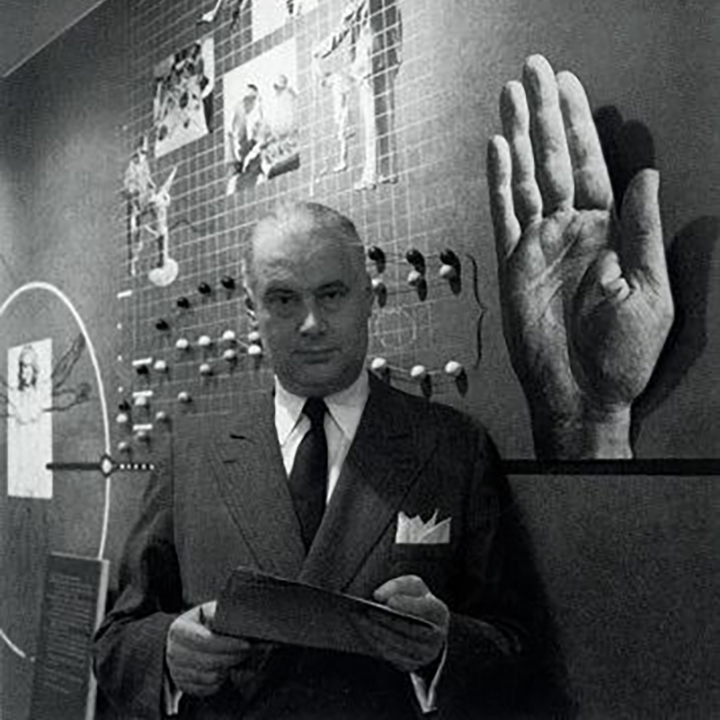
Will Burtin photographed by Arnold Newman, 1940s
The mythic image of the artistic genius who creates brilliant work in solitude is so powerful that it serves to define genius in other fields — even when the myth has nothing to do with the way genius manifests itself in these other endeavors. Malcolm Gladwell outlined this compellingly in a recent essay, where he described the way that scientists work, how ideas circulate and build upon each other in the community of researchers and inventors, and how innovation is often a communal project. Contrasting starkly with our culture’s romantic notion of isolated writers, composers or artists, Gladwell maintained that most scientific “geniuses” are quite unlike artists, in that they are often not really the authors of their own breakthroughs so much as they are the synthesizers of the work of their peers; that “genius is not a unique source of insight…merely an efficient source of insight.”
Reading this, I couldn’t help but think of William Burtin, one of graphic design’s emigré “pioneers” who came to the United States during the 1930s as economic or political refugees, whose Modernist-inflected work changed everything about the way that graphic design was both considered and made in the U.S. (Alexey Brodovich, Herbert Bayer, Herbert Matter and Ladislav Sutnar, among others, were members of this same group of refugees.)
A large part of Burtin’s career was dedicated to visualizing concepts in science and technology: inspired by these fields, he focused his practice upon them. More than half a century later, he provides an inspiring model for design practice and the role of the designer.
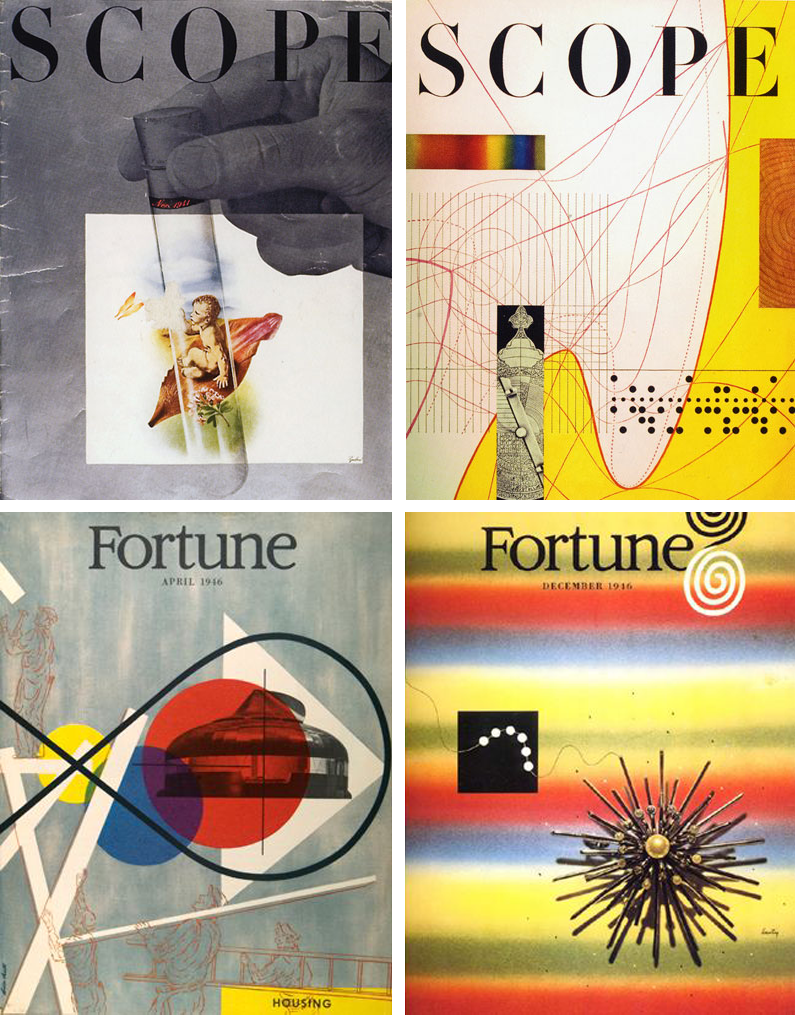
A collection of Will Burton's covers.
Burtin referred to himself as an “integrator,” a term he used to describe his own position as both a visual researcher and an interpreter of science, who could deliver ideas with a level of insight deepened by the form he bestowed upon concepts. He clearly wavered between regarding himself as an artistic “creator” whose work was informed by the precepts and forms of visual Modernism, and depicting his practice as a sort of science of visual interpretation, where the work was informed by a discipline of engaged research. It is the dual nature of Burtin’s practice that remains of interest to contemporary designers seeking to bridge that gap between participation in research, and the potential use of graphic design as a way of developing and sharing knowledge.
Will Burtin’s story — from his trade education in Germany (a 4-year typographic apprenticeship at high school) and early work as an enthusiastic advertising designer, through the interruption of his emergency immigration (his wife was Jewish, and he declined working for the Nazis), and across the course of his career following his arrival in the U.S. — is presented in Design and Science: The Life and Work of Will Burtin. (Reviewed here by Design Observer contributor Rick Poynor.) Like all of the emigré “pioneers,” Burtin brought an amazing amount of talent and energy (along with plain old ambition) to his modernist approach, but he was also the beneficiary of the particular context of New York at that time: the latter years of the Depression, when modern design was gaining attention for its innovativeness in the face of a bleak economy. It was hard, but Burtin found himself work (with the help of the intrepid Robert L. Leslie of The Composing Room). Between his arrival in New York City in 1938, and his induction into the Army in 1943 (where he became part of the “Presentation Branch” of the OSS, along with Saul Steinberg and Russell Lynes), Burtin succeeded enough to have worked for Architectural Forum, Upjohn Company, and had by this time begun teaching design at Pratt.
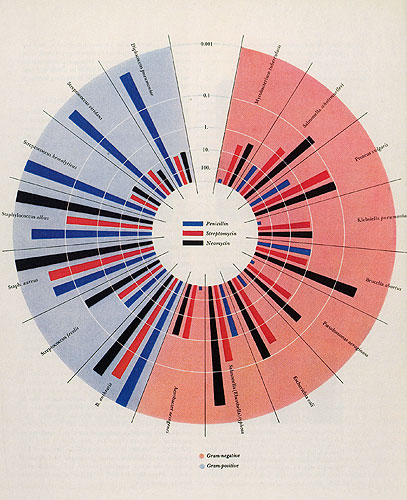
Scope, diagram of the impact of Penicillin, Streptomycin, and Neomycin on bacteria, 1951.
The Army work he was most proud of involved the design of manuals — hard-core information design for “grunts” — that required filmic editing of photographic imagery coordinated with copy for maximum legibility and retention. Burtin was a true believer in the power of design to deliver important and necessary ideas, and his military work proved that he was flexible enough to see the design opportunities provided by any audience or situation. But it still seems shocking that his discharge from the Army in 1945 was personally solicited by Henry Luce, the publisher of Fortune magazine, on the grounds that it was in the national interest that Burtin would apply his sophisticated skills in managing and visualizing the editorial content that Fortune intended to deliver to its audience, the American managerial class.
At Fortune, Burtin brought his imagination to bear on the kick-starting of the American and global economy, the challenges of post-war reconstruction, the creation of a renewed consumer culture, and in particular, the ascendancy of technology and engineering as sources of innovation and wealth. Every issue of Fortune explodes with visual intensity that Burtin orchestrated, combining documentary photography, conceptual illustration, graceful and sober typography, and an amazing array of approaches to charts, graphs and technological diagrams. Burtin truly established the role of the art director who is a creative equal to the editorial team, and whose visual translation of the content is as filled with ideas as the content itself. With his visual interpretations, Fortune managed to deliver information in a manner that communicated its intelligence visually, simultaneously educating and entertaining its audience.
With the support of a single client, the Upjohn Company, Burtin left Fortune to start his own studio in 1949. After redesigning their corporate identity, he turned his attention to Scope, their pharmaceutical journal. While the design of Scope extended along the lines of Fortune, Burtin re-defined his practice beyond the confines of the advertising or publications art director, as his design was so integrated with the editorial side of the journal.
Integration: The New Discipline in Design, an exhibition that Burtin put together about his own work (which opened at The Composing Room in 1948), implored designers to step up to social engagement through the use of their skills to clarify and explicate a rapidly-changing world to an audience hungry for understanding. The exhibition had an impact beyond its specific venues, since Burtin’s text for it was published in Graphis, and he was invited to lecture on this work extensively. The design of Integration, and Burtin’s metaphor of the designer as the fulcrum by which form, color, material, texture and light can pivot to otherwise abstract concepts such as time, space, energy and motion, was his entry to the next, and most remarkable phase of his career, in which he engaged in the design of large-scale public exhibitions requiring the translation of scientific concepts into three-dimensional models.
It was Burtin who proposed the first of these projects, The Cell (1958), in part as a challenge to his longtime client, Upjohn. (He sensed that Scope was losing its audience, but he also was responding to his own increased passion for research.)
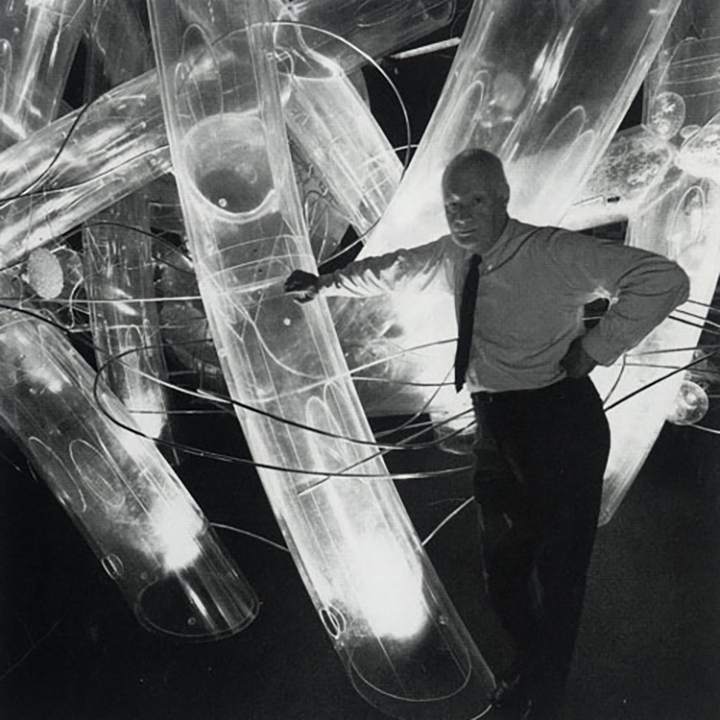
Defense of Life exhibition, Will Burtin and one of his "exhibit sculptures," 1960s
In order to design a plausible model of a human blood cell (and to respond to the relatively new focus on cytology as the engine for future developments in biology and medicine, four years after Watson and Crick), Burtin threw himself into research and consulted with scores of scientists working at the most speculative edges of their fields. Burtin’s conversations and questions were all directed toward the goal of creating a visualization that would, through its three-dimensional translation, give the research back to the scientists in a way that they themselves had not gotten to “see,” and which would also work as a teaching tool for the public. It is important to realize that Burtin’s gigantic structures (x 1,000,000) were not literal enlargements of microscopic images already available, but rather, were diagrammatic — and kinetic — depictions of processes and functions that were only beginning to be understood. This was equally true in his subsequent large-scale exhibits for Upjohn, The Brain (1960), Metabolism (1963), Genes in Action (1966) and Defense of Life (1968), all produced with the Director of Special Projects at Upjohn, Dr. Bruce McLeod. In addition to consulting with many scientists, Burtin was engaged with lighting consultants, electricians, model-makers, photographers, and his own staff, so these models were truly massive collaborations. Even so, they remained a reflection of Will Burtin’s specific vision of design as a vehicle for understanding.
The most remarkable passages in Design and Science describe the process by which the exhibition team (in the presentation of potential visual translations of concepts derived from their interviews with disparate scientists working on similar subjects) was able to reconcile —and even assist in — the advance of several important ideas through the design process. Their method was to “float” several versions of visual translations of concepts to the scientists in an effort to help bridge conceptual gaps in the scientists’ own thinking. So while the exhibits, on the outside, were presented as brilliant expressions of corporate enthusiasm, the models went way beyond the traditional realm of public communication, to get to the core of a participation in the very development of the science. The fact that several of these models had long runs as public exhibitions is a testament to their extraordinary communicative value.
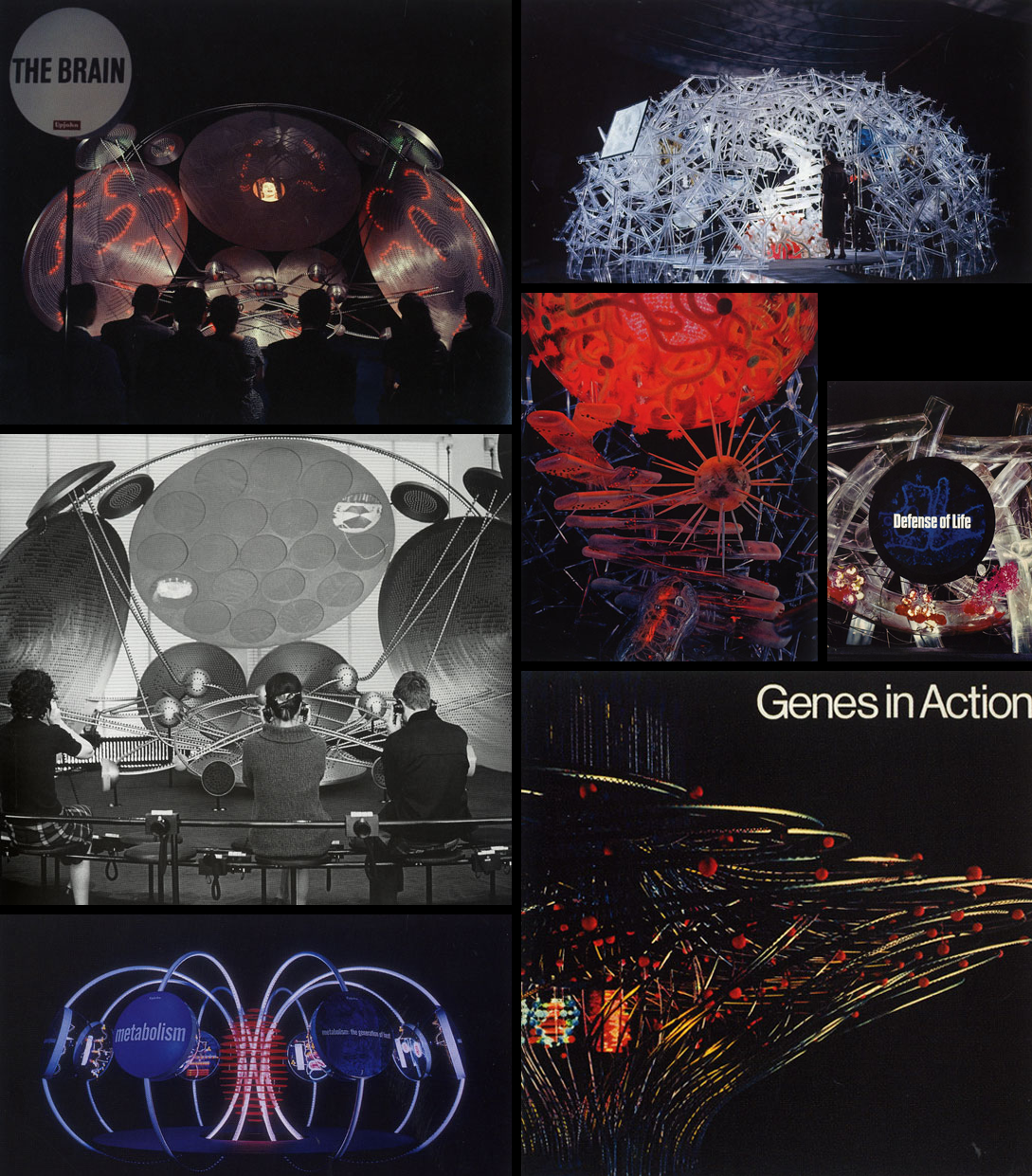
A collection of Will Burton's exhibits.
Burtin’s career is a difficult one to encapsulate as he was engaged in such an active and complex range of activities. Clearly, ego was not a problem for Burtin: he had a high regard for his own gifts and the confidence (despite the limits of his trade-school education) that as a designer, he could participate meaningfully in the highest realms the post-war culture. His own practice had transcended the “commercial art” model most common in the 1950s and 60s, and had gone on to synthesize design thinking with education and technology.
Burtin also engaged in early efforts to expand the ways that design was understood, both within design culture and across the profession into business and education. He was among the founding members of the International Design Conference at Aspen, a forum that established the template for intense cross-disciplinary exchange. Two more remarkable events chaired by Burtin and sponsored by the Aaron Burns’ International Center for the Typographic Arts, the Vision 65 and Vision 67 conferences, included lists of participants that crossed all boundaries, including Max Bill, Buckminster Fuller, Umberto Eco, and Jean Tinguely. Such events hint at the social, cultural, artistic and technological range that Burtin ascribed to design practice, which went far beyond the dictates of running his own office. (This was possibly the only aspect of his professional career that he seemed less inspired by: his office always seemed a means to a much larger and more interesting end than becoming profitable.)
We are facing a time within the design profession when there seems to be an unprecedented enthusiasm for the potential of design. Yet there is a general disaffection, particularly among more idealistic designers, with “conventional design practice” — an anachronism that may have transcended the old “commercial art” model but still describes a relatively static relationship between the designer who executes for a client who commissions. The disaffection with this model is timely, since the economic crisis seems to threaten this stasis. However, the paucity of alternative models draws many designers back to that culturally-approved model of creativity — the solo genius, the artist in the studio. When you combine this turn away from the conventions of practice with the rhetoric of authorship (that has had such a deep influence on designers in recent years), one finds the desire — and unquestionable ability — of designers to develop and use their “voice.”
The question remains as to what uses “voice” in design might have? To read the story of Will Burtin’s life work is to be reminded, in the most emphatic way, of another direction design activity can take — of what can happen when a designer “goes deep” into a subject through the visual expression of ideas, creating a scenario to support the ongoing project. The passion can begin in a personal, even idiosyncratic place, but design thinking pushes beyond the studio and toward a larger world. The resulting synthesis between times, tools, and relationships translated into form that engages an audience — whether a building, a product, an exhibition or a poster — describes the peculiarly social nature of what we ultimately recognize, even today, somewhat reluctantly, as genius in design.

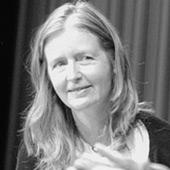
Comments [15]
Has there ever been any question as to rebuilding pieces of his Upjohn exhibits (as there has been some thought to reviving Mathematica)? It seems to me that much of his later work needed to be experienced to really understand how strong it was.
I wonder if collaborations such as these could even continue today. I realize most people my age are looking for alternative models of design practice, but something tells me that most of us don't want to get in bed with large pharm companies (or even an IBM like the Eames Office) today. Cynicism and (likely appropriate) caution persists. It actually opens up a huge question as to whether corporations, and by inclusion their designers, today: 1) have the funding to engage designers in this manner; and 2) even care to engage the public as they did then. Cynicism aside, its hard to fathom. There was such an intense optimism post-war that seems to be missing from much of our current world. The green movement seems to have some similarities, but I think its safe to say none of them have the budgets of those large internationals nor the huge audiences. I truly hope their are effective models blossoming that can be sustainable and deal with smaller budgets and more focused audiences.
04.22.09
02:10
04.24.09
12:13
04.24.09
02:34
(2) Yes there has been talk by Wellcome Trust in London to possibly recreate the Upjohn Cell Exhibit.
(3) Thanks to all who respond.
04.25.09
09:54
04.27.09
12:21
05.02.09
02:45
I’m not sure. It seems to me that the notion of the ‘timeless’ work, a contested category in contemporary readings of art and literature, is even more problematic in the case of design. If design is, as is often attested, always design for something - aimed at communicating a particular message to a particular audience for a particular end – then the claim to timelessness (or a certain autonomy from the historical moment of its production) would seem to go against an essential aspect of what design is?
That a work of design (or body of work) will frequently speak to us outside of the context for which it was originally intended, even growing in relevance beyond its own historical moment, should not disguise the facts that it is this context, and that moment, which give the work its particular shape and vital force.
At the risk of uttering heresies, I wonder whether all great design might not be ‘dated’? Most canonical, historically significant design certainly appears so, if by 'dated' one means works that appear so much to be an expression of their era or of a particular historical aesthetic or ‘style’ that it seems impossible that they might have emerged in another time or place, and which evoke associations with these before any other content. Of course, such works never seemed ‘dated’ in their original context; the best design often simply appears, to those who are its original audience, to be ‘good’; much as what we designate ‘good design’ today will, and rightfully, appear hopelessly of our current moment to a later generation of design-observers.
Seem in this light, if Burtin seems “so ‘40s” (or ‘50s, or ‘60s), so ‘dated,’ it may be because his work so perfectly encapsulates a number of specific choices and concerns of postwar design: just as does Rand’s, or Glaser’s, or Hofmann’s, and so on. Such work did not just reproduce these choices as so many stylistic formulae; it helped create them, establishing new paradigms and raising new questions and possibilities that were eagerly taken up, reworked, modified (and, in many cases, diluted) by other designers. If Burtin’s work seems to be too much of a piece with certain attitudes and approaches in postwar design, it is, in part, because he helped to orchestrate them in the first place.
05.03.09
11:23
05.04.09
11:44
I assembled the full list of speakers and presenters to be included in Design and Science, but want of space ultimately kept them out of our book. Readers can find the complete list of delegates to both conferences on the Design and Science page of my URL.
Robert Fripp,
Co-author, Design and Science: The Life and Work of Will Burtin
09.21.09
10:52
12.13.09
07:31
12.18.09
03:17
01.02.10
06:26
01.02.10
06:29
01.02.10
06:33
While I also enjoy the idea of the solo genius of design, honing his or her unique talents behind closed doors, then blossoming out into the world, finding their voice and all that, I am also skeptical as to how often this is occurring now, as opposed to at any other point in design's history. One might make the argument that today's conditions are actually less evocative of that genius quality, at least in the arts, as the last half century has failed to produce any recognized geniuses in any of the fine arts fields. Individuals like Will Burton seem to be fewer and farther between all the time.
04.21.10
10:23